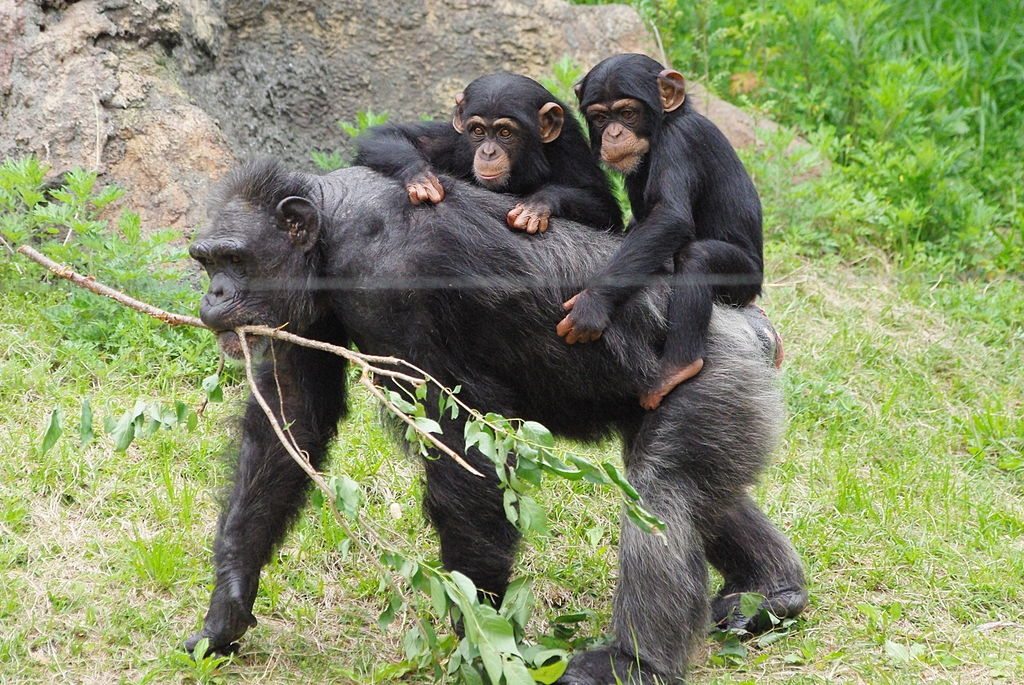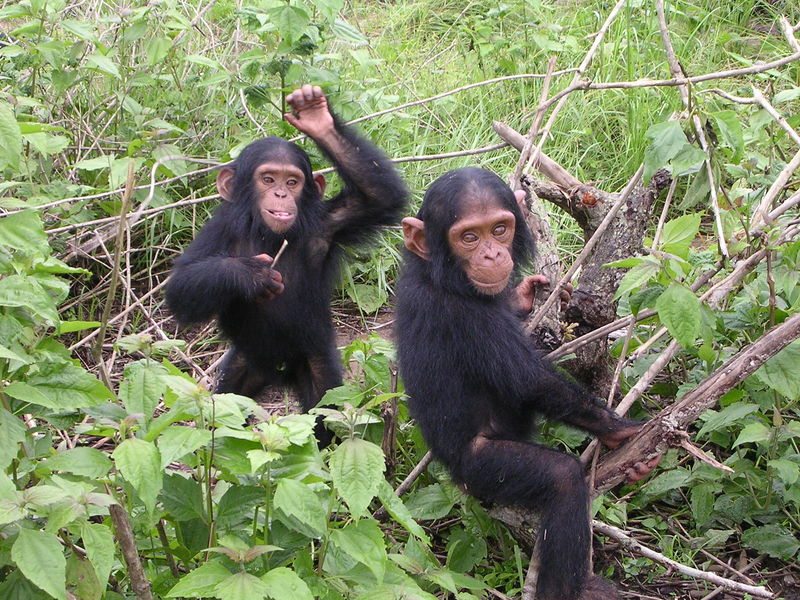Although they look cute and cuddly and are generally somewhat smaller than us, chimpanzees can be quite aggressive and are phenomenally strong. They can easily kill a human being without really thinking about it – so testing the ‘cute and cuddly’ bit is not necessarily a good idea!
Interesting Facts About Chimpanzees.
Chimpanzee Facts – General
1 – The first thing one should remember about chimpanzees is – they are not monkeys! They are apes, like gorillas, orangutans and of course, humans. In fact, they are genetically our closest living relatives on this earth, sharing more than 98% of our genetic ‘blueprint’. This means that less than 2% of our DNA is different from that of the chimps! They are believed to have last shared an ancestor with us some 4-6 million years ago.
2 – Chimpanzees are African hominids of the genus Pan, of which there are two living species – the first is the Common Chimpanzee, Pan troglodytes, from Central and West Africa, and the other the Bonobo, Pan Paniscus, that lives in the Democratic Republic of Congo’s forests. There are four sub-species of the Common chimp – the Central (P.t. troglodytes), Western (P.t. verus), Eastern (P.t. schweinfurthii) and Nigeria-Cameroon (P.t. ellioti) chimpanzees – guess where each one lives …!
3 – Although chimps are our closest living relatives, their brains have been measured at around 282-500cc, and human brains are approximately three times that size, so we’re still well ahead of them in that area, at least.
4 – Like many other animals, chimps are declining in the wild, and both the common chimp and the bonobo are listed as ‘endangered’ on the IUCN Conservation Red List, mainly due to the ever-worsening habitat loss and to hunting of the species for bushmeat. Estimates of remaining numbers are around 170,000-300,000 for common chimps, but it is thought that for Bonobos, there may only be around 29,500 to 50,000 still living.
5 – Because chimpanzee physiology is so similar to humans, they can catch the diseases and infections that afflict humans, but they don’t have the resistance and antibodies we’ve built up, leaving them far more vulnerable than we are – meaning that the more they come into contact with us, the more they are affected by our bugs etc, and problems that merely make us ill can kill them quite easily. It doesn’t help when we turn them into laboratory animals and perform nasty and gruesome tests on them, either.
6 – Chimps have only two major predators – leopards and humans. Leopards pose a particular danger because they can climb trees almost as easily as the chimps can, giving them nowhere to run to. However, if they manage not to get killed first, they can live around 40 years in the wild, and up to 60 years in captivity.
Image courtesy of Flickr under Wikipedia commons
Chimpanzee Facts – Characteristics
7 – Male common chimps stand at up to 5ft 8in (1.7m) and can weigh up to 150lb (70kg), but the females are a fair bit smaller. They are generally stocky, and have very long arms, a petite body and short legs, allowing them to walk on all fours whilst their torso is more or less upright. The bonobo is generally a little shorter and thinner than its ‘common’ relative, but it has longer limbs.
8 – Chimps have black hair all over most of their body, leaving just the face, palms of hands and soles of feet clear, and they are tailless. The exposed skin can be anything from pale pink to very dark, with older individuals generally having darker skin than younger ones.
Don’t Miss: Ethiopian movies, Questions for couples, Daily nation Kenya, Trivial pursuit questions
9 – Chimps are partly terrestrial, spending a significant amount of time on the ground during the day, but they are mostly arboreal, especially when it comes to eating and sleeping. They are very agile climbers when up in the trees and find most of their main food, fruit, up there.
10 – Mostly diurnal, chimpanzees can be active at night when there is good moonlight to see by, and they prefer to live in the tropical forests of their home country, although those forests are receding everyday now.
Image courtesy of Delphine Bruyere under Wikipedia Commons
Chimpanzee Facts – Behaviour
11 – Chimps live in large communities with strict hierarchies and everyone knowing his or her place. The males and females have separate hierarchical ‘ladders’ and the top or ‘alpha’ male is considered higher than the alpha female – but it is often the females who choose who will be the alpha male, even ousting one they don’t approve of and backing another to the position instead. Males look to acquire dominance for access to mating rights but in the females, it’s access to resources such as food that is gained by moving higher up the ladder.
12 – Chimpanzees are one of the few animals that have hands with an opposable thumb – and they know how to use them, too! They can not only grasp branches when climbing and hold various items such as fruit firmly, they also throw things like stones at threatening predators with frightening accuracy!
13 – It was Jane Goodall who, in October 1960, first observed that chimps use tools, one of the very few animals that can do so. They use large sticks as clubs and to dig into termite mounds, then a small stick will be used to ‘fish’ out the termites. At other times they will use a stone to break open nuts, and they build nests by lacing together branches of trees and lining them with soft leaves and twigs. They have even been observed to sharpen sticks with their teeth to make spears, which they use to stick into bush babies and get them out of their holes in the trunks of trees, and chew leaves to make them absorbent so they can dip them in water and suck them dry.
14 – Communication between chimps is usually in the form of vocalisations, facial expressions and hand gestures, so very similar to the non-verbal human variety. They are quite noisy animals and will hoot, grunt and scream sometimes for hours on end, also banging their hands on hollow trees, effectively drumming on them. They also employ recognisable emotive expressions, such as baring their teeth and snarling when threatened, becoming tight-lipped and glaring prior to attacking and making public displays of affection such as hugging.
15 – They are also very tactile, holding hands, grooming each other and sometimes even kissing in greeting. Older individuals are usually very patient with the youngsters, and mothers will help each other with babysitting chores when necessary.
16 – Mostly living on fruit, chimpanzees are omnivores and can (and will) eat anything that appeals and is available, from insects and greenery to eggs and meat – even carrion. The list of foods they are known to eat includes hundreds of different items.
17 – Chimpanzee gestation takes eight months, resulting in the birth of a single baby, and babies are totally reliant on their mothers, riding on her back from the age of six months until they are about two and remaining with her until they are around five years old or so. They are considered juvenile until they reach around nine or ten when they attain sexual maturity. Females can inherit their position in the dominance hierarchy from their mothers, but males have to work it out for themselves.
Chimpanzee Facts – Chimpanzees and Us

18 – Many studies have been carried out with the aim of finding out just how near to us chimps are in relation to things like language. They cannot, of course, talk the way we do, but several chimps have learned sign language, some knowing as many as several hundred signs. So far, however, scientists are not convinced that they are learning a language in the way a human child would, with most feeling that they are merely copying what they see the humans do.
19 – Chimps often turn up in literature and films, but they are rarely shown as anything more than sidekicks, clowns or childlike, young companions. The Typhoo adverts were classics of the chimp ‘clown’ genre, showing them dressed as people, apparently acting parts and ‘speaking’ lines (with the actual speech recorded separately by human actors).
20 – Chimp characters as individuals, central to the plot, are usually only found in science fiction. The books and films of ‘The Planet of the Apes’ are the most well-known example of this, but short stories and novels by Robert A Heinlein, Robert Silverberg and David Brin have shown chimps suing for better treatment, developing religiosity and being altered to gain human-level of intelligence.


